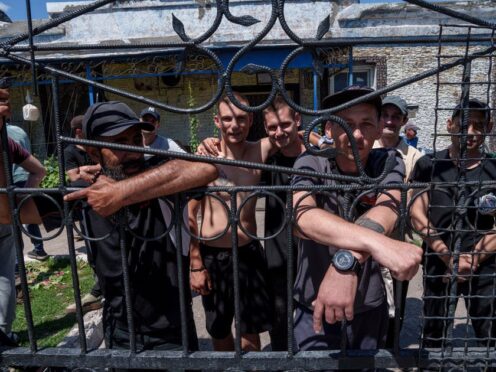
At a rural penal colony in southeast Ukraine, several convicts stand under barbed wire to hear an army recruiter offer them a shot at parole.
In return, they must join the fight against Russia.
“You can put an end to this and start a new life,” said the recruiter, a member of a volunteer assault battalion.
“The main thing is your will, because you are going to defend the motherland. You won’t succeed at 50%, you have to give 100% of yourself, even 150%.”

Ukraine is expanding conscription to cope with acute battlefield shortages, more than two years into fighting against Russia’s full-scale invasion.
Its recruiting efforts have turned, for the first time, to the country’s prison population.
Although Ukraine does not announce any details of troop deployment numbers or casualties, frontline commanders openly acknowledge that they are facing serious manpower problems, as Russian continues to build up forces in eastern Ukraine and make incremental gains westward.
More than 3,000 prisoners already have been released on parole and assigned to military units after such recruitment was approved by parliament in a controversial mobilisation bill last month, Ukrainian deputy justice minister Olena Vysotska told The Associated Press.
About 27,000 inmates could potentially be eligible for the new programme, according to justice ministry estimates.

“A lot of the motivation comes from (inmates) wanting to return home a hero, and not to return home from prison,” Ms Vysotska said.
Ernest Volvach, 27, wants to take up the offer. He is serving a two-year sentence for robbery, at the penal colony in Ukraine’s Dnipropetrovsk region. He works in the kitchen, ladling of food into tin bowls.
“It’s stupid to sit here doing nothing,” he said, adding that since the start of the war he has wanted to “do something for Ukraine” and have the opportunity to enlist. “Now it’s appeared.”
Ukrainian soldiers on active duty are typically identified only by their first name, or a call sign, for security reasons. Many of the inmates at the Dnipropetrovsk penal colony also asked to be identified only by their first names to avoid difficulties if they enlist.
Another inmate, 30, who gave his name only as Volodymyr, makes rivets at a penal colony workshop. He said he plans to volunteer after his sentence ends in one year, but would not do so now because there is effectively no home leave under the parole programme.

Prisoners can get the conditional release after an interview, medical exam, and a review of their conviction. Those convicted of rape, sexual assault, murdering two or more people or crimes against Ukraine’s national security are not eligible.
Ukrainian officials are keen to draw a distinction between their programme and recruitment in Russia of convicts to serve in the notorious Wagner mercenary group.
Those fighters typically have been funnelled to the deadliest battles, the officials say, but the Ukrainian programme aims to integrate the inmates into regular Ukrainian frontline units.
The country has a prison population of some 42,000, according to figures forwarded by the government to the European Union.
After screening, paroled inmates are rushed to basic training at camps where they learn how to handle weapons and other combat fundamentals. Training is completed later once they join the individual units.
Paroled inmate Mykhailo, 29, joined an assault course and said it was hard to keep up with the physical demands after months of relative inactivity in prison – clambering in and out of armed personnel carriers and running through obstacle courses.
“I decided to sign up for the Ukrainian Volunteer Army because I have a family at home, children, parents,” he said, speaking over the noise of gunfire at a shooting range. “I will be more useful in the war.”
Ms Vysotska said interest in the military parole programme has exceeded early expectations, and that it could provide as many as 5,000 new recruits. “That would definitely help,” she said.

Enjoy the convenience of having The Sunday Post delivered as a digital ePaper straight to your smartphone, tablet or computer.
Subscribe for only £5.49 a month and enjoy all the benefits of the printed paper as a digital replica.
Subscribe